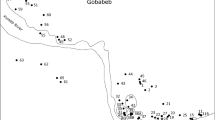Summary:
In addition to a single queen and workers, colonies of the ant Crematogaster smithi from the Chiricahua Mts., Arizona, may contain one or several "large workers". These are specialized for laying viable, unfertilized eggs. However, it is unclear whether in queenright colonies these eggs are all eaten or some of them develop into males. Using microsatellite markers we investigated the genetic structure of colonies of C. smithi. The effective mating frequency of queens is close to one. At least in one of four colonies that contained both a queen and "large workers" and produced males in the laboratory, the genotype of some males suggested worker reproduction.
Similar content being viewed by others
Author information
Authors and Affiliations
Additional information
Received 4 January 2000; revised 18 March 2000; accepted 22 March 2000.
Rights and permissions
About this article
Cite this article
Heinze, J., Strätz, M., Pedersen, J. et al. Microsatellite analysis suggests occasional worker reproduction in the monogynous ant Crematogaster smithi. Insectes soc. 47, 299–301 (2000). https://doi.org/10.1007/PL00001719
Issue Date:
DOI: https://doi.org/10.1007/PL00001719




